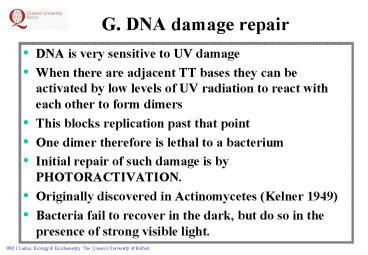DNA is very sensitive to UV damage PowerPoint PPT Presentation
1 / 14
Title: DNA is very sensitive to UV damage
1
G. DNA damage repair
- DNA is very sensitive to UV damage
- When there are adjacent TT bases they can be
activated by low levels of UV radiation to react
with each other to form dimers - This blocks replication past that point
- One dimer therefore is lethal to a bacterium
- Initial repair of such damage is by
PHOTORACTIVATION. - Originally discovered in Actinomycetes (Kelner
1949) - Bacteria fail to recover in the dark, but do so
in the presence of strong visible light.
2
G. DNA damage repair. Cont.
Formation of DIMERS
Covalent bonds
UV Damage
Replication Blocked Lethal / no growth
3
G. DNA damage repair cont...
- UV - DNA Damage - Cell Death
- UV - Bright visible light - survival !
- 3 Steps
- 1.Photolyase (encoded by phrA and phrB genes in
E. coli) recognises distortion at dimer. - 2.Light activates photolyase
- 3.Dimer cleaved
4
G. DNA damage repair. Cont.
UV
Dimer
PHOTOREACTIVATION
Photolyase recognises distortion and binds
Energy from visible light activates lyase. Dimers
removed and photolyase released
5
G. DNA damage repair cont...
- EXCISION REPAIR
- T-phage Host Cell Reactivation (Setlow 1964)
- UV resistance determinants discovered by
screening - uvrA,B and C mutants VERY UV sensitive
- DNA damage (dimers and other damage)
- Uvr A,B,C endonuclease cut
- DNA Pol I digestion and polymerisation
- Ligation and repair completed
6
Excision repair........
UV DNA damage
Repair of gap
Endonuclease action
Ligation
Digestion and polymerisation
7
H. Homologous Recombination
- Discovery of recombination functions
- Search began in 1960s using E.coli.
- Clarke (1965) and Howard-Flanders (1966)
- Hfr crosses screening for rec minus recipient
- 3 Classes of mutant found
recA(58 min) VERY UV senstitve 10-4
rec recB recC(61 min) Less UV sensitive 10-1
-10-3 rec recD discovered in 1985 Map near to
srlC and thyA genes (latter used to map by
co-transduction
8
H. Homologous Recombination cont...
- Now many rec genes known to have involvement
(over 28!) - Other routes involving rec E,F,J,N,O,Q,R etc
are possible (not considered here) - Homology of over 40-50 bps needed for efficient
rec - Single strands or Duplexes can be involved
- Conjugation/transformation SS transferred
- Transduction / DS transferred
- Also many other DS/DS recombinations possible
9
H. Homologous Recombination cont...
- Biochemical action of Rec proteins
- RecA protein is a DNA dependant ATPase and a
specific protease. - Binds SS DNA and promotes strand exchange
- Unwinds DNA (ATP)
- RecBCD protein complex - the RECOMBINASE
- Attaches near chi sequence (GCTGGTGG)
- ATP dependant cutting of the DNA
10
H. Homologous Recombination cont...
Meselson- Radding Model for Bacterial
Recombination
1. Single strand nick
5. Ligation
2. Dissociation of ssDNA
6. Branch migration
3. Assimilation into D-Loop
7. Complete Recombination
4. D-Loop Digestion
11
I. Homologous Recombination and repair.
- Repair normally at low level
- lexA gene identified as a regulator
- Recombine normally
- But NO increased UV mutagenesis (ie 30 dimers
produces no extra mutants). Higher doses required - LOW DOSE - Error-free repair
- HIGH DOSE - Error repair INDUCED
- Known as the SOS System in E.coli
12
I. Homologous Recombination and repair.
- LexA is an autoregulated repressor
- Represses level of activity of many genes
- Collectively called DNA Inducible (din) genes
- Includes uvrA,B,C,D and sfi etc...
- RecA protease activity Cleaves LexA repressor
- Also ?CI repressor inducing lysis
In Summary DNA repair and recombination are
closely associated. They share functions and are
co-regulated. Consider the impact on evolution of
diversity for the final TUTORIAL
13
SOS System in E.coli
14
SOS System in E.coli

